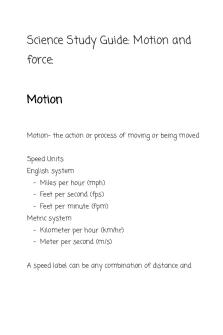Ch13 Notes - study guide PDF

| Title | Ch13 Notes - study guide |
|---|---|
| Author | Tamago Steve |
| Course | Principles Of Accounting 1 |
| Institution | Florida Atlantic University |
| Pages | 2 |
| File Size | 36.8 KB |
| File Type | |
| Total Downloads | 9 |
| Total Views | 184 |
Summary
study guide...
Description
Building blocks of Financial statement analysis: Liquidity and efficiency, profitability, market prospects, solvency. Liquidity and Efficiency: ability to meet short term obligations and to efficiently generate revenues. Solvency: refers to a company’s long-run financial viability and its ability to cover long-term obligations. Profitability: ability to provide future revenues and meet long term obligations. Market prospects: ability to generate positive market expectations. 3 common tools of financial statement analysis: horizontal, ratio, vertical analysis Horizontal analysis: comparison of a company’s financial condition and performance across time Vertical analysis: comparison of a company’s financial condition and performance to a base amount Ratio analysis: measurement of key relations between financial statement items. Dollar Change = Analysis period amount – Base period amount Percent Change (%) : Analysis period amount – Base period amount/Base period amount X 100 Continuing operations: shows revenues, expenses, and income from ongoing operations. Discontinued segments: reports income from operating and selling or closing a segment. Extraordinary items: reports gains and losses that are both unusual and infrequent Earnings per share: reports info for each of the 3 subcategories of income Price earnings ratio: Market price per common share divided by earnings per share. Dividend yield is used to compare the dividend paying performance of different investment alternatives. Computed by taking annual cash dividends per share divided by market price per share. Financial statement includes: Balance sheet, Notes to financial statements, income statement, statement of stockholder’s equity, statement of cash flows. Debt to Equity ratio is a measure of solvency that takes total liabilities divided by total equity. The amount of income before deductions for interest expense and income taxes is the amount available to pay interest. The times interest earned ratio takes this income divided by interest expenses to determine the risk for creditors. Profit margin reflects a company’s ability to earn net income form sales. It is measured by expressing net income as a percent of sales. Computed by taking net income divided by net sales. Return on total assets is computed by taking net income divided by average total assets. Current ratio, or current assets divided by current liabilities, is used to evaluate a company’s ability to pay its short-term obligations. The acid test ratio takes the sum of cash, short-term investments, and current receivables and divides the total by current liabilities. Determines immediate short-term debt paying ability
Account receivable turnover ratio: net sales divided by average accounts receivable Inventory turnover: the measure of how long a company holds inventory before selling. Calculated by dividing the cost of goods sold by the average inventory. Days’ sales uncollected is a measure of liquidity of receivables. Computed by dividing the current balance of receivables by the annual net sales and then X by 365. Total asset turnover reflects a company’s ability to use its assets to generate sales and is an important indication of operating efficiency. Computed by taking net sales divided by average total assets. Return on common stockholder’s equity: (Net income – preferred dividends) divided by average common stockholders’ equity. Working capital: the amount of current assets less current liabilities. Dividend yield is used to compare the dividend paying performance of different investment alternatives. Computed by taking annual cash dividends per share divided by market price per share....
Similar Free PDFs

Ch13 Notes - study guide
- 2 Pages

ECON2121 Notes 14 - ch13
- 55 Pages

Study guide - Bios notes
- 7 Pages

Study guide Apush - notes
- 18 Pages

Lecture Notes, Study Guide
- 6 Pages

questions/notes/ study guide
- 1 Pages

Science Study Guide - notes
- 14 Pages

questions/notes/ study guide
- 3 Pages

Economics Study Guide Notes
- 5 Pages

Study Guide Notes
- 17 Pages

questions/notes/ study guide
- 3 Pages

questions/notes/ study guide
- 1 Pages

Nursing study guide - notes
- 46 Pages

Ch13 - Lecture notes ch 13
- 62 Pages

Final Exam Notes/Study Guide
- 29 Pages
Popular Institutions
- Tinajero National High School - Annex
- Politeknik Caltex Riau
- Yokohama City University
- SGT University
- University of Al-Qadisiyah
- Divine Word College of Vigan
- Techniek College Rotterdam
- Universidade de Santiago
- Universiti Teknologi MARA Cawangan Johor Kampus Pasir Gudang
- Poltekkes Kemenkes Yogyakarta
- Baguio City National High School
- Colegio san marcos
- preparatoria uno
- Centro de Bachillerato Tecnológico Industrial y de Servicios No. 107
- Dalian Maritime University
- Quang Trung Secondary School
- Colegio Tecnológico en Informática
- Corporación Regional de Educación Superior
- Grupo CEDVA
- Dar Al Uloom University
- Centro de Estudios Preuniversitarios de la Universidad Nacional de Ingeniería
- 上智大学
- Aakash International School, Nuna Majara
- San Felipe Neri Catholic School
- Kang Chiao International School - New Taipei City
- Misamis Occidental National High School
- Institución Educativa Escuela Normal Juan Ladrilleros
- Kolehiyo ng Pantukan
- Batanes State College
- Instituto Continental
- Sekolah Menengah Kejuruan Kesehatan Kaltara (Tarakan)
- Colegio de La Inmaculada Concepcion - Cebu
